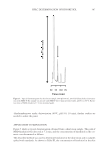J. Cosmet. Sci., 64, 381–389 (September/October 2013) 381 Determination of hinokitiol in skin lotion by high-performance liquid chromatography–ultraviolet detection after precolumn derivatization with 4-fl uoro-7-nitro-2,1,3-benzoxadiazole YASUHIKO HIGASHI and YOUICHI FUJII, Department of Analytical Chemistry, Faculty of Pharmaceutical Sciences, Hokuriku University, Kanazawa 920-1181, Japan. Accepted for publication February 28, 2013 Synopsis Hinokitiol, a potent, broad-spectrum antibacterial agent, is a component of various personal care products. In this study, the concentration of hinokitiol in skin lotion was analyzed by means of high-performance liquid chromatography–ultraviolet detection (380 nm) after precolumn derivatization with 4-fl uoro-7-nitro-2,1, 3-benzoxadiazole (NBD-F). A standard curve was obtained after derivatization of the authentic compound with NBD-F in borate buffer (pH 9.0) at 60°C for 10 min. The retention time of NBD-hinokitiol was 7.2 min. The calibration plot was linear in the range of 0.2 to 4 mg/ml with an r2 value of 0.9985, and the lower limit of detection was 0.05 μg/ml (at a signal-to-noise ratio of 3, absolute amount of 0.33 ng/20 μl injection). The coeffi cient of variation was less than 9.4%. It was found that the amount of hinokitiol in the tested skin lotion was 194 ± 14 μg/ml (range: 180–212 μg/ml). Recovery in addition-recovery tests was within the range of 84.5% to 98.0%. This system is simple, sensitive, and convenient, and should be suitable for routine quality assessment of personal care products containing hinokitiol. INTRODUCTION Hinokitiol (β-thujaplicin, 4-isopropyl-2-hydroxycyclohepta-2,4,6-trien-1-one Fig. 1) is a naturally occurring toxic compound belonging to the class of tropolones that contain an unsaturated seven-membered carbon ring. The compound is found in heartwood of several cupressaceous plants, such as western red cedar (Thuja plicata), eastern white cedar (T. occidentalis), hinoki cypress (Chamaecyparis obtusa), and hiba (Thujopsis dolabrata) (1,2). Since hinokitiol has potent antibacterial activity (minimum inhibitory concentration of 0.2 μg/ml for Staphylococcus epidermidis and Daedalea dickinsii) (2,3), it is often added to skin lotions, body soaps, and other personal care products. Direct determination of hinokitiol, by means of gas chromatography (GC) or high- performance liquid chromatography (HPLC) is diffi cult because of the chelating activity Address all correspondence to Yasuhiko Higashi at y-higashi@hokuriku-u.ac.jp.
JOURNAL OF COSMETIC SCIENCE 382 of the tropolone ring, its instability to heat, and its adsorption on the stationary phase. Quantitative determinations of hinokitiol by GC and capillary GC have been performed after derivatization with trimethylsilyl chloride and with diazomethane, respectively (1,4). Hanafusa et al. (5) presented an HPLC determination of hinokitiol in cosmetics by HPLC with ultraviolet (UV) detection by adding copper (II) to the mobile phase to form the hinokitiol–copper (II) complex. However, the sensitivity of these methods was not discussed. Also, it is diffi cult and time-consuming to treat waste containing copper (II). Endo et al. (6) developed a sensitive HPLC determination of hinokitiol based on formation of the difl uoroborane derivative, with the detection limit of 40 pg. Dyrskov et al. (7) determined hinokitiol by using a capillary zone electrophoresis–UV method, which provided the detection limit of 0.21 μM. Recently, we established an HPLC-dual UV (240 and 345 nm) method of hinokitiol determination in personal care products by using a reversed-phase C4 column with detection limits of 0.005 μg/ml (absolute amount of 1 ng) and 0.01 μg/ml (absolute amount of 2 ng) at 240 and 345 nm, respectively (8). Nevertheless, a simple, sensitive, and convenient assay that would be suitable for routine quality control of personal care products containing hinokitiol is still needed. As a fl uorescent labeling agent of primary and secondary amino groups for HPLC-fl uorescence detection (9–13), 4-fl uoro-7-nitro-2,1,3-benzoxadiazole (NBD-F) has been used and it has also been used as a UV-labeling reagent reactive with the phenolic hydroxyl group of N-acetyltyrosine, chlorophenols, and eugenol (14–16), and the phenol-like hydroxyl group of kojic acid (17). Hinokitiol contains a reactive hydroxyl group (vinyl alcohol) derived from the tropolone structure. In this article, we present a simple HPLC–UV method for the determination of hinokitiol in skin lotion after precolumn derivatization with NBD-F. The derivatization scheme is illustrated in Fig. 1. Our data and validation results indicate that this method will be suitable for routine quality control purposes. EXPERIMENTAL APPARATUS The HPLC system consisted of a model LC-10ATvp pump (Shimadzu, Kyoto, Japan), a Rheodyne injection valve (Cotati, CA) with a 20-μl loop, and a model SPD-10Avp UV detector (Shimadzu) operating at 380 nm. The HPLC column (C18-MS-II, Nacalai Tesque, Kyoto, Japan) was 150 × 3.0 mm i.d., containing 5 μm particles of C18 packing material. The quantifi cation of peaks was performed using a Chromatopac Model C-R8A Figure 1. Scheme of hinokitiol derivatization with NBD-F.
Purchased for the exclusive use of nofirst nolast (unknown) From: SCC Media Library & Resource Center (library.scconline.org)





















































































